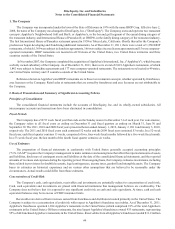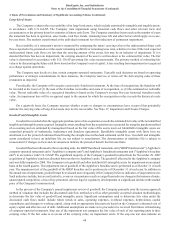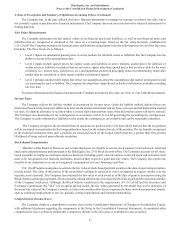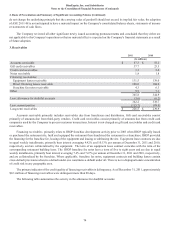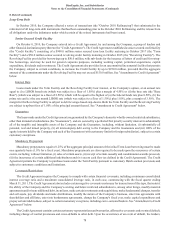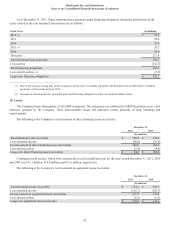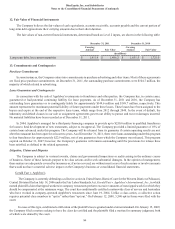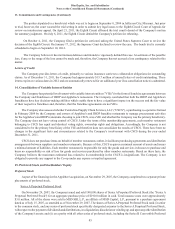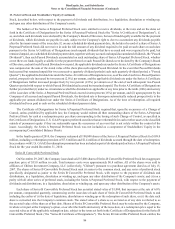IHOP 2011 Annual Report Download - page 94
Download and view the complete annual report
Please find page 94 of the 2011 IHOP annual report below. You can navigate through the pages in the report by either clicking on the pages listed below, or by using the keyword search tool below to find specific information within the annual report.
DineEquity, Inc. and Subsidiaries
Notes to the Consolidated Financial Statements (Continued)
4. Assets Held For Sale (Continued)
76
franchise restaurant was taken back to be refranchised.
Assets sold of $71.2 million comprised: 66 Applebee's company-operated restaurants located in Massachusetts, New
Hampshire, Maine, Rhode Island, Vermont and parts of New York; 36 Applebee's company-operated restaurants in the St. Louis
market area; 30 Applebee's company-operated restaurants in the Washington, D.C. market; the land and building of the single
Applebee's company-operated restaurant; and two parcels of land on which Applebee's franchised restaurants are situated.
Additionally, the two IHOP restaurants held for sale (one held as of December 31, 2010 and one taken back during 2011) were
refranchised.
The balance of assets held for sale at December 31, 2011 of $9.4 million was primarily comprised of 17 Applebee's company-
operated restaurants located in a six-state market area geographically centered around Memphis, Tennessee, one parcel of land on
which a refranchised Applebee's formerly company-operated restaurant is situated and three parcels of land previously intended
for future restaurant development. See Note 25, Subsequent Events.
All assets reported as held for sale are part of the company restaurant operations segment.
5. Property and Equipment
Property and equipment by category is as follows:
Land
Buildings and improvements
Leaseholds and improvements
Equipment and fixtures
Construction in progress
Properties under capital lease obligations
Less accumulated depreciation and amortization
Property and equipment, net
2011
(In millions)
$ 111.6
58.8
409.8
100.4
4.2
61.4
746.2
(272.0)
$ 474.2
2010
$ 136.3
61.4
506.6
106.2
6.2
62.4
879.1
(266.9)
$ 612.2
The Company recorded depreciation expense on property and equipment of $37.7 million, $48.1 million and $51.9 million
for the years ended December 31, 2011, 2010 and 2009, respectively.
Accumulated depreciation and amortization includes accumulated amortization for properties under capital lease obligations
in the amount of $29.7 million and $27.4 million at December 31, 2011 and 2010, respectively.
Capitalized interest, net of amortization, is not significant at December 31, 2011 and 2010.
6. Goodwill
The significant majority of the Company's goodwill and other intangible assets arose from the November 29, 2007 acquisition
of Applebee's. As of December 31, 2011 and 2010, the balance of goodwill was $697.5 million, of which $686.7 million has been
allocated to the Applebee's franchise reporting unit and $10.8 million to the IHOP franchise reporting unit.
In accordance with U.S GAAP, goodwill must be evaluated for impairment, at a minimum, on an annual basis, and more
frequently if the Company believes indicators of impairment exist. Such indicators include, but are not limited to, events or
circumstances such as a significant adverse change in the business climate, unanticipated competition, a loss of key personnel,
adverse legal or regulatory developments, or a significant decline in the market price of the Company's common stock. In the
process of the Company's annual impairment review, the Company primarily uses the income approach method of valuation that
utilizes a discounted cash flow model to estimate the fair value of its reporting units. Significant assumptions used to determine
fair value under the discounted cash flows model include future trends in sales, operating expenses, overhead expenses, depreciation,
capital expenditures, and changes in working capital, along with an appropriate discount rate.
During fiscal 2011 and 2010, the Company made periodic assessments as to whether there were indicators of impairment,
particularly with respect to the significant assumptions underlying the discounted cash flow model, and determined an interim test
of goodwill was not warranted. Accordingly, the Company performed its annual test of goodwill impairment in the fourth quarter
of 2011 and 2010. In the first step of each year's impairment test, the estimated fair value of both the IHOP and Applebee's


